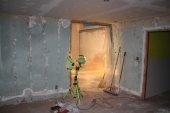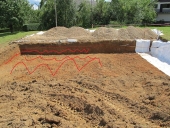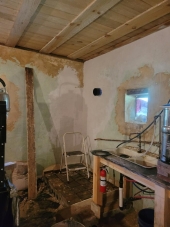




... it´s about time to get a signature ...





Works at a residential alternative high school in the Himalayas SECMOL.org . "Back home" is Cape Cod, E Coast USA.





... it´s about time to get a signature ...




Paramount Natural Design-Build Architect, Engineering Services, GC, LLC.




... it´s about time to get a signature ...




Paramount Natural Design-Build Architect, Engineering Services, GC, LLC.




... it´s about time to get a signature ...




 I'm not sure what lime you got over there is it not a hydraulic NHL 2, 3.5, 5 stated on the container? If so I'd start with a 3.5 then move to a 5 if I had to that has more binder in it but is not as permeable. If this is an exterior application go with 5. You may as you said be better off mixing mostly lime plaster on lime brick to get a good bond after the surface prep I described. Add a little soil depending on much clay it has, lots of clay less. Reason being is clay has bigger internal molecular voids to manage more moisture content(up to 40% by volume) than lime (up to 30% by volume), and the brick has some clay in it to bond to. You might try some fly ash (~5-10%) as a pozzolan if it is cheap and available, it can react with lime, stabilize soil, or portland cement in the brick for a better bond. I get it free at my utility company.
I'm not sure what lime you got over there is it not a hydraulic NHL 2, 3.5, 5 stated on the container? If so I'd start with a 3.5 then move to a 5 if I had to that has more binder in it but is not as permeable. If this is an exterior application go with 5. You may as you said be better off mixing mostly lime plaster on lime brick to get a good bond after the surface prep I described. Add a little soil depending on much clay it has, lots of clay less. Reason being is clay has bigger internal molecular voids to manage more moisture content(up to 40% by volume) than lime (up to 30% by volume), and the brick has some clay in it to bond to. You might try some fly ash (~5-10%) as a pozzolan if it is cheap and available, it can react with lime, stabilize soil, or portland cement in the brick for a better bond. I get it free at my utility company.
Paramount Natural Design-Build Architect, Engineering Services, GC, LLC.




... it´s about time to get a signature ...





Paramount Natural Design-Build Architect, Engineering Services, GC, LLC.




... it´s about time to get a signature ...





Paramount Natural Design-Build Architect, Engineering Services, GC, LLC.




Terry Ruth wrote:Thanks for the window info. I wish I could speak German.
... it´s about time to get a signature ...




Paramount Natural Design-Build Architect, Engineering Services, GC, LLC.




... it´s about time to get a signature ...
 1
1




Do you know the burlap trick? This is essential knowledge for plastering light-straw clay walls. You use it to cover any slick material that would not otherwise accept clay plaster easily: framing lumber, exposed concrete, flashing, etc.
Take some loose-weave burlap (either coffee sacks or landscaping burlap) and cut a strip as wide as the material you want to cover, plus an inch or two extra so that it will cover the seam between materials and come over onto the straw-clay. Then make a paste mixture of 50% thick clay slip (thick milkshake or pudding consistency) and 50% flour paste (see recipe below). Rub some of this pate onto the straw-clay that the burlap will cover (you don't need to apply the paste to the other surfaces, but it won't hurt.) Soak the burlap in the paste, squeeze out any extra liquid and smooth the burlap onto the surface, rubbing hard with the palm of your hand to remove air pockets. Then let the burlap dry completely before plastering over it. This is an amazing technique; I have yet to find anything it won't stick to, and it provides a rough, fibrous, clayish surface that clay plasters bond to easily.
To make flour paste, mix 1 part white flour (or "white whole wheat" or white rice flour) into 2 parts cold water, beating with a wire whisk to eliminate lumps. Then pour that mixture into 4 parts water which is already boiling on the stove. Bring back to a boil, stirring with wire whisk all the time. If it's lumpy, you can strain through a wire colander or window screen.
... it´s about time to get a signature ...




so there might be condensation-water in that glue-burlap-layer which contains organic material. so it might rot under the plaster, which would not be a nice thing. that might work for interior walls, but i would not risk that on a cold outside wall.
Paramount Natural Design-Build Architect, Engineering Services, GC, LLC.

|
Won't you please? Please won't you be my neighbor? - Fred Rogers. Tiny ad:
The new purple deck of permaculture playing cards
https://www.kickstarter.com/projects/paulwheaton/garden-cards
|






